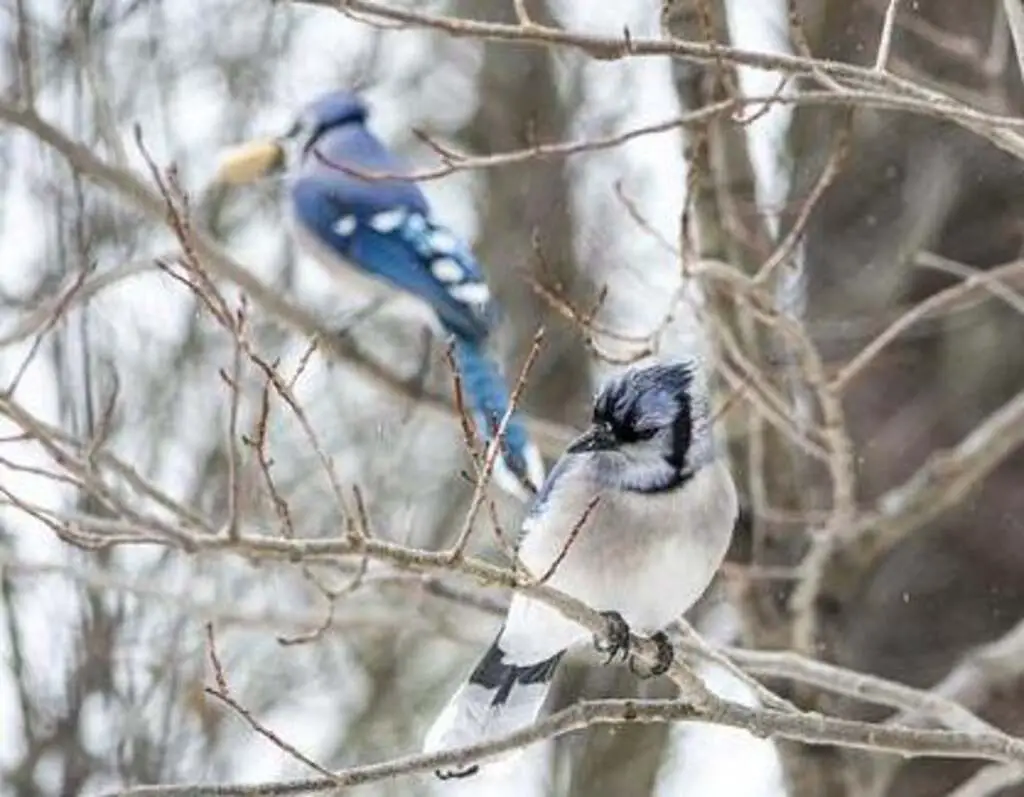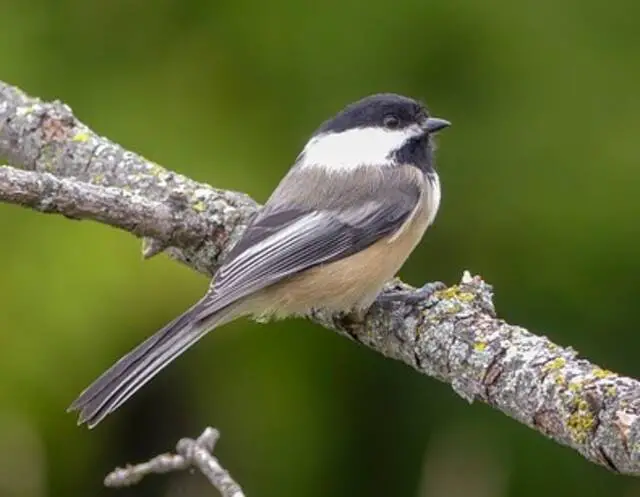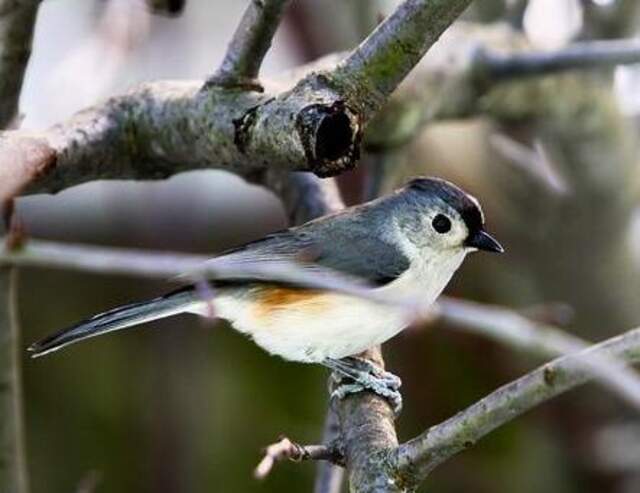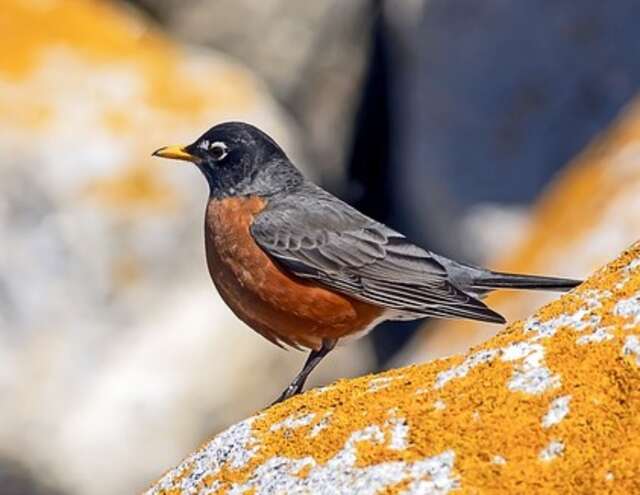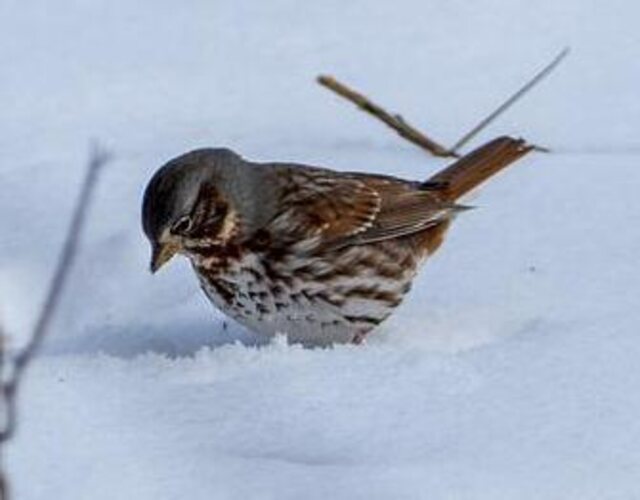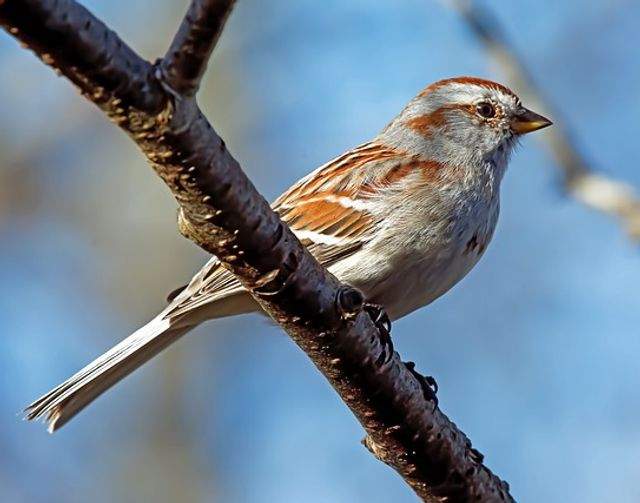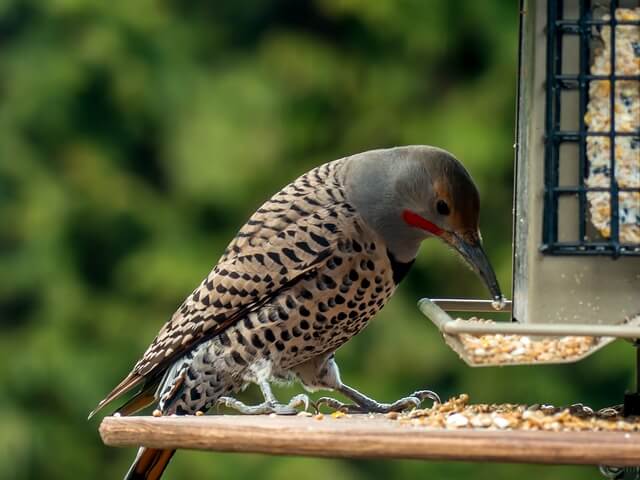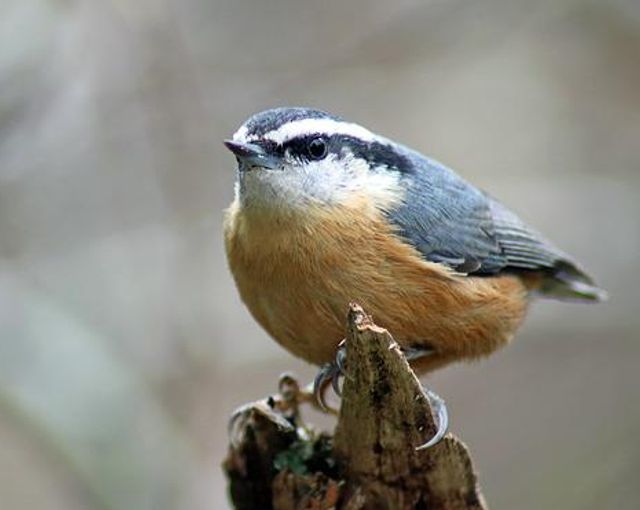Welcome to our expert guide on the 24 backyard winter birds in Massachusetts! As winter blankets Massachusetts in snow, it also brings forth a diverse array of avian visitors to backyard feeders and habitats.
In this comprehensive guide, we’ll explore the fascinating world of Massachusetts’s winter birdlife, featuring 24 species commonly observed during the colder months.
From vibrant cardinals to agile chickadees, learn about their behaviors, habitats, and survival strategies in the face of winter’s challenges.
Whether you’re a seasoned birder or a newcomer to birdwatching, join us as we celebrate the beauty and resilience of Massachusetts’s backyard winter birds.
Table of Contents
- 1 Backyard Winter Birds in Massachusetts
- 1.1 Black-capped Chickadee
- 1.2 Blue Jay
- 1.3 Northern Cardinal
- 1.4 American Crow
- 1.5 Tufted Titmouse
- 1.6 Downy Woodpecker
- 1.7 Dark-eyed Junco
- 1.8 White-breasted Nuthatch
- 1.9 Song Sparrow
- 1.10 Mourning Dove
- 1.11 American Goldfinch
- 1.12 American Robin
- 1.13 House Sparrow
- 1.14 European Starling
- 1.15 House Finch
- 1.16 White-throated Sparrow
- 1.17 Red-bellied Woodpecker
- 1.18 Carolina Wren
- 1.19 Hairy Woodpecker
- 1.20 American Tree Sparrow
- 1.21 Rock Pigeon
- 1.22 Northern Mockingbird
- 1.23 Northern Flicker
- 1.24 Red-breasted Nuthatch
- 2 Author
Backyard Winter Birds in Massachusetts
Black-capped Chickadee
- Length: 4.7-6.0″ in (12.0-15.2 cm)
- Weight: 0.3-0.5 oz (9-14 g)
- Wingspan: 6.3-8.3 in (16-21 cm)
- Scientific Name: Poecile atricapillus
- Frequency of Occurrence: 49.71%(Statistic by: eBird)
- Where To Find Them: This bird is seen in Massachusetts in winter. The Black-capped Chickadee can be found in some locations in Massachusetts, such as the White Mountains and the Berkshire Hills.
- How to Attract Them: The best way to attract these birds is by providing a platform or hopper filled with food, as well as a supply of black sunflower seeds and peanuts.
General Information: The Black-capped Chickadee is a common bird found throughout much of North America. There are several subspecies, but the distribution range for the species as a whole is very large. They inhabit every continent except Antarctica, and in many regions there are multiple populations.
The Chickadee is mostly a ground feeder, eating seeds, berries, plant matter, insects and other small animals. In the winter, they can be seen in large numbers at birdfeeders, where they get their main source of food.
Handpicked Related Post: Unique Black-capped Chickadee Facts You Need To Know!
Blue Jay
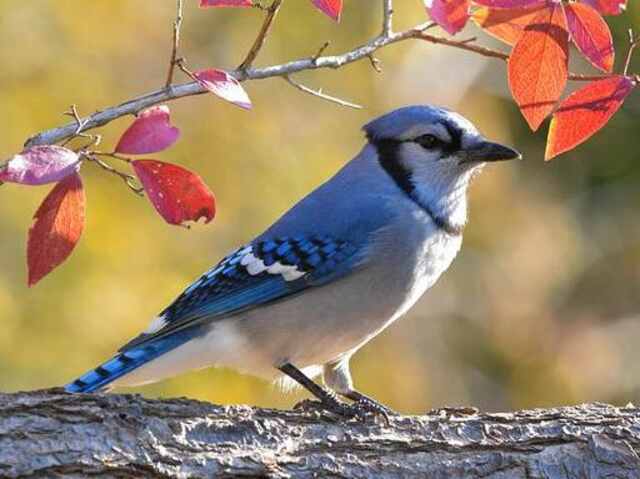
- Length: 9.8-11.8 in (25-30 cm)
- Weight: 2.5-3.5 oz (70-100 g)
- Wingspan: 13.4-16.9 in (34-43 cm)
- Scientific Name: Cyanocitta cristata
- Frequency of Occurrence: 39.74%
- Where To Find Them: The blue jay is a common bird in Massachusetts during the winter. They can be found in both urban and rural places. They are most commonly seen in the colder parts of the state, such as Boston and Worcester.
- How to Attract Them: Blue jays are attracted to a variety of feeds, including Suet, mealworms, cracked corn, sunflower seeds and shelled peanuts. Providing these items in various locations around your yard will help the blue jay population thrive.
General Information: The blue Jay is a common bird found in a variety of habitats across North America. The distribution range for the blue Jay includes most of Canada and the United States, with isolated populations in Mexico, Cuba and Central America.
The blue Jay is a member of the crow family and is the only species in its genus. The blue Jay feeds primarily on seeds and nuts, but will also consume insects. In winter, blue Jays can be seen visiting bird feeders to feed for sustenance.
Handpicked Related Post:
- 15 Best Bird Feeders For Blue Jays (Tried & Tested 2022)
- What Attracts Blue Jays to your Yard?(Expert Tips)
- What Does A Blue Jay Eat? (10 Favorite Foods Revealed!)
Northern Cardinal
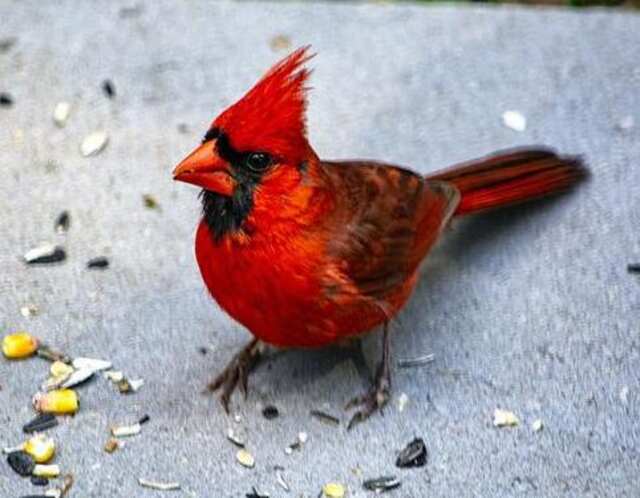
- Length: 8.3-9.1 in (21-23 cm)
- Weight: 1.5-1.7 oz (42-48 g)
- Wingspan: 9.8-12.2 in (25-31 cm)
- Scientific Name: Cardinalis cardinalis
- Frequency of Occurrence: 37.52%
- Where To Find Them: The northern cardinal is frequently spotted in Massachusetts during winter. They are most commonly seen in the south-central and southeastern parts of the state. They can also be found in the Pioneer Valley and North Shore regions.
- How to Attract Them: One key thing is to provide them with food that they love. Northern cardinals love cracked corn, suet and mealworms. You can also give them sunflower seeds and peanuts as treats on a platform feeder.
General Information: Northern cardinals are found primarily in the northern United States and Canada, with small populations also found in the south-central and southeastern regions of the country. They prefer mostly deciduous or mixed forests with some coniferous trees, but can also be found in moist prairies.
Their diet consists mostly of seeds, fruit, and nuts, as well as the occasional insect. During the winter, they commonly visit bird feeders to eat suet or other food items.
Handpicked Related Post:
- Where Are Cardinals Found? Best Spots to Look!
- Best Birdhouse for Cardinals 2022 (Tested And Rated)
- 10 Best Bird Feeders for Cardinals (Rated for 2022)
American Crow
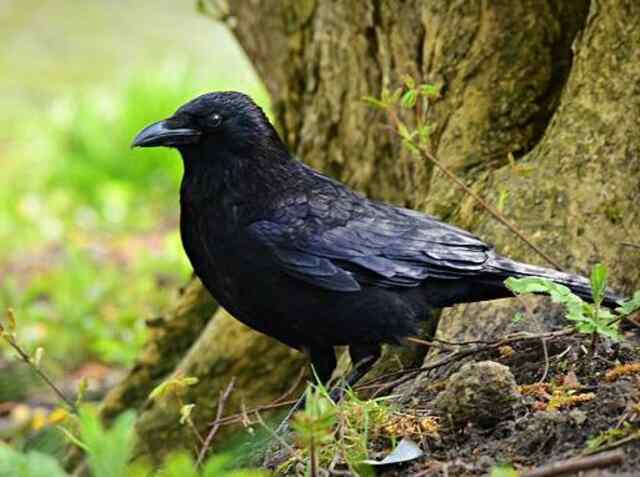
- Length: 15.8-20.9 in (40-53 cm)
- Weight: 11.2-21.9 oz (316-620 g)
- Wingspan: 33.5-39.4 in (85-100 cm)
- Scientific Name: Corvus brachyrhynchos
- Frequency of Occurrence: 34.96%
- Where To Find Them: Some of the locations where American crows can be found in Massachusetts during winter include Boston, Worcester, and Springfield.
- How to Attract Them: In order to attract the crow to your property, you may want to consider providing them with food sources such as cracked corn or peanuts. You can also try setting up a black oil sunflower seed feeder in order to offer them a nutritious snack.
General Information: The American crow is a fairly typical bird in North America. The crow’s distribution range includes most of the continent, but it is mostly found in the eastern United States and Canada.
It prefers open areas with plenty of food and water, such as farmlands, cities, and suburbs. The crow mainly feeds on small animals, but it also eats fruits and seeds. In winter, crows often visit human habitations to get food.
Handpicked Related Post:
Tufted Titmouse
- Length: 5.5-6.3 in (14-16 cm)
- Weight: 0.6-0.9 oz (18-26 g)
- Wingspan: 7.9-10.2 in (20-26 cm)
- Scientific Name: Baeolophus bicolor
- Frequency of Occurrence: 34.09%
- Where To Find Them: The tufted titmouse is a small bird that is seen in Massachusetts in winter. This bird can be found in areas such as the Berkshires, the Pioneer Valley, and Cape Cod.
- How to Attract Them: Attracting the Tufted Titmouse is easy when you have some of their favorite foods on hand. Sunflower seeds, peanuts and suet are all great food sources for the Tufted Titmouse. Keep your bird feeder full of these items, and you’ll be sure to attract this cute little bird!
General Information: The Tufted Titmouse is a common bird found throughout much of North America. The distribution range of the Tufted Titmouse extends from southern Canada and the northern United States all the way to Florida.
The Tufted Titmouse is a small bird with a tuft of feathers on its head. It eats insects and seeds, and its diet includes a wide range of insects such as beetles, grasshoppers, ants, and caterpillars. In the winter, the Tufted Titmouse is one of the few birds that can be seen visiting yards.
Handpicked Related Post: How to Attract Tufted Titmouse to my Yard? (Explained)
Downy Woodpecker
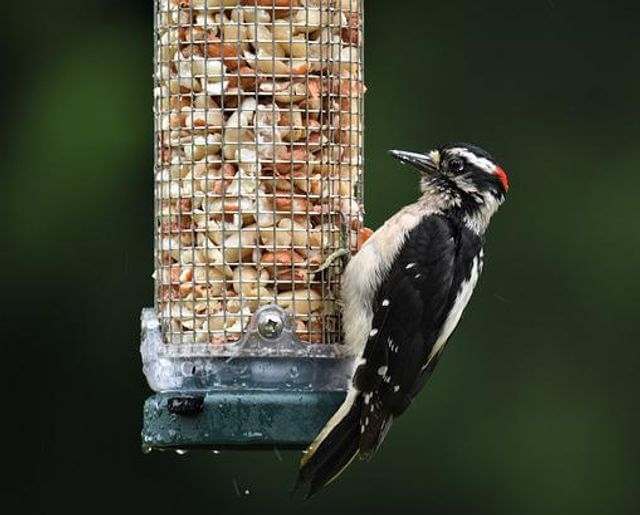
- Length: 5.5-6.7 in (14-17 cm)
- Weight: 0.7-1.0 oz (21-28 g)
- Wingspan: 9.8-11.8 in (25-30 cm)
- Scientific Name: Picoides pubescens
- Frequency of Occurrence: 34.07%
- Where To Find Them: In Massachusetts, this bird can be seen in areas such as the Berkshires, the North Shore, and Cape Cod.
- How to Attract Them: Sunflower seeds are a good option because they’re tiny and easy to cache, and they provide plenty of energy for these birds. Cracked corn is another good option, as it’s high in energy and contains plenty of essential nutrients.
General Information: The Downy Woodpecker is a common resident of North America. It ranges from the Great Lakes region to the southern tip of South America, and from the Pacific coast to the Appalachian Mountains. The Downy Woodpecker is mainly a woodland bird, but it also inhabits open areas near human habitation.
The Downy Woodpecker feeds mainly on insects, but it will also eat seeds and berries. In winter, the Downy Woodpecker can be a common visitor to many parts of North America.
Handpicked Related Post:
- How to Attract Downy Woodpeckers to Your Yard? (Easy!)
- 7 Birds That Look Like Downy Woodpecker (Explained)
Dark-eyed Junco
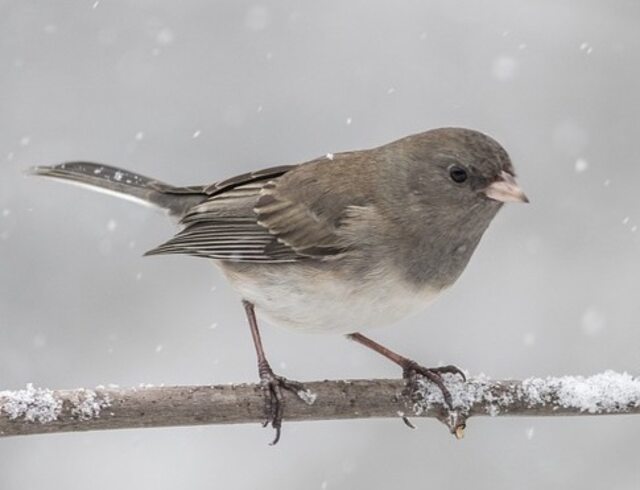
- Length: 5.5-6.3 in (14-16 cm)
- Weight: 0.6-1.1 oz (18-30 g)
- Wingspan: 7.1-9.8 in (18-25 cm)
- Scientific Name: Junco hyemalis
- Frequency of Occurrence: 33.41%
- Where To Find Them: They are usually seen in winter, especially along the coast. The Dark-eyed Junco can be found in areas such as Cape Cod, Martha’s Vineyard, Nantucket, and Gloucester.
- How to Attract Them: To attract this interesting bird to your yard in winter, try scattering cracked corn around your garden or feeding them black sunflower seeds. Be sure to keep an eye out for these birds – they’re hard to see against their surrounding landscape and can be difficult to photograph.
General Information: The dark-eyed junco is a common bird found throughout the eastern United States. This bird ranges in distribution from southern Canada to Central America. It inhabits open woodland, grasslands, and agricultural areas. The diet of this bird consists mostly of seeds, nuts, and grains.
The dark-eyed junco is a winter visitor to many parts of the United States. This bird is most commonly seen in Florida, but it has been reported as far north as New Jersey, Massachusetts and Pennsylvania.
Handpicked Related Post: Fun Facts About Dark-eyed Juncos
White-breasted Nuthatch
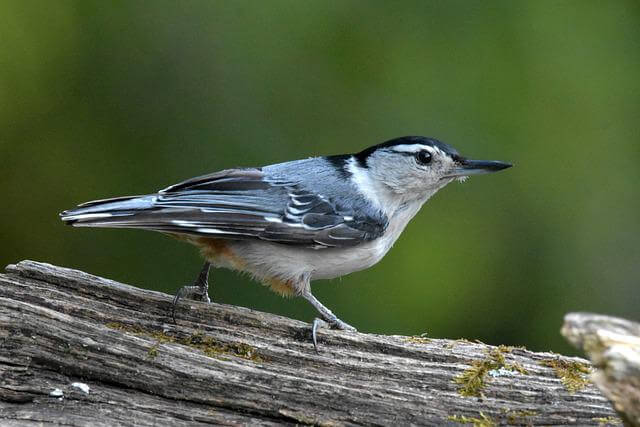
- Length: 5.1-5.5 in (13-14 cm)
- Weight: 0.6-1.1 oz (18-30 g)
- Wingspan: 7.9-10.6 in (20-27 cm)
- Scientific Name: Sitta carolinensis
- Frequency of Occurrence: 30.91%
- Where To Find Them: . They are most commonly seen in the Boston metropolitan area, but can be found as far west as Springfield and as far south as Plymouth. They are generally seen in wooded areas, suburbs and parks throughout the state.
- How to Attract Them: They feed mainly on insects, but will also eat fruit and seeds. One way to attract this bird is to offer black sunflower seeds in winter. The seeds will contain a high amount of oil, which the nuthatch will enjoy feeding on.
General Information: The white-breasted nuthatch, a small but popular bird in North America, is found throughout most of the eastern half of the continent. It is a versatile bird that eats a variety of insects, seeds and fruits.
The nuthatch’s distribution range extends from southern Canada to Florida and west to Texas and Oklahoma. In winter, this bird is commonly seen in parks and other open habitats where there are plenty of nuts and seeds for consumption.
Handpicked Related Post: How to Attract Nuthatches to your Backyard? Expert Tips!
Song Sparrow
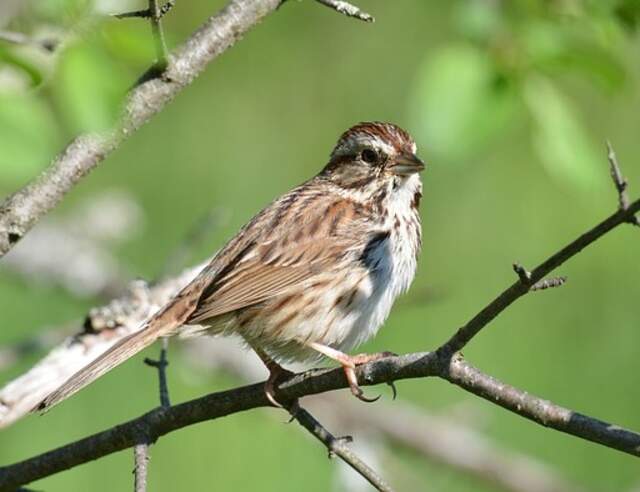
- Length:4.7-6.7 in (12-17 cm)
- Weight: 0.4-1.9 oz (12-53 g)
- Wingspan: 7.1-9.4 in (18-24 cm)
- Scientific Name: Melospiza melodia
- Frequency of Occurrence: 28.32%
- Where To Find Them: In Massachusetts, the Song Sparrow can be found in the southeastern part of the state and in portions of Cape Cod.
- How to Attract Them: If you’re looking to attract song sparrows to your property, a platform feeder with sunflower seeds or millet in winter may be the perfect solution. Platform feeders are easy to set up, and they can be positioned in any location that’s accessible to the birds.
General Information: The song sparrow is a common bird in North America. It ranges from the Arctic tundra to the southern United States, and from the tropics to high elevations. The song sparrow is an insectivorous bird, eating mostly insects but also consuming small amounts of seeds and grains.
In winter, the song sparrow is a common visitor to many parts of the country, including regions that it does not typically inhabit during the rest of the year. These birds are most commonly seen in early morning or late afternoon hours.
Handpicked Related Post: How to Attract Sparrows to your Backyard? (Like A Pro)
Mourning Dove

- Length: 9.1-13.4 in (23-34 cm)
- Weight: 3.4-6.0 oz (96-170 g)
- Wingspan: 17.7 in (45 cm)
- Scientific Name: Zenaida macroura
- Frequency of Occurrence: 27.76%
- Where To Find Them: They can be found in many areas, but some of the most popular places to see them are located in the Berkshires and the North Shore.
- How to Attract Them: Attracting Mourning Doves to your feeding station can be a challenge, but with a little know-how and some helpful accessories, it’s not impossible. A platform feeder with sunflower seeds is a great way to start. Safflower, nyjer and cracked corn are also good choices for the bird. In winter, try giving them millet or peanuts.
General Information: The Mourning Dove is a common bird that can be found in the eastern and central United States. This bird is most commonly found in the eastern half of the country, but it has also been spotted in the Midwest and the western part of the country.
The Mourning Dove prefers open woodlands with lots of fruit trees, but it can also be found near human habitation. The diet of this bird consists mostly of seeds, fruit, and waste grain. In winter, the Mourning Dove can be seen as a winter visitor in many parts of North America.
Handpicked Related Post: Facts About Mourning Doves – 10 Things You Need To Know!
American Goldfinch
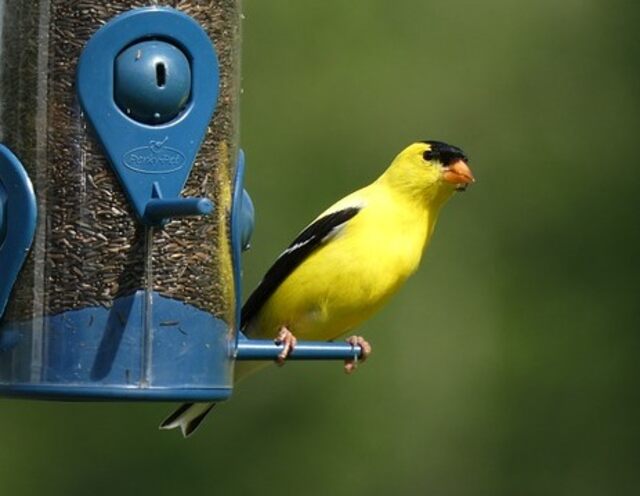
- Length: 4.3-5.1 in (11-13 cm)
- Weight: 0.4-0.7 oz (11-20 g)
- Wingspan: 7.5-8.7 in (19-22 cm)
- Scientific Name: Spinus tristis
- Frequency of Occurrence: 26.72%
- Where To Find Them: They can be found in the colder parts of the state, such as Barnstable County, Cape Cod, and the Berkshire Mountains.
- How to Attract Them: There are many ways to attract the American Goldfinch, but one of the best is to feed them black oil sunflower seeds and hulled sunflower chips in winter. These seeds are high in protein and fat, so they will keep the birds well-nourished throughout the winter. You can also try giving them niger seed, which is a favorite food of this bird.
General Information: The American Goldfinch is a common bird in North America. They are distributed in most of the lower 48 states, and into some parts of Canada. The habitat range includes both open areas with trees, as well as more urban settings. They prefer areas with lots of seeds, but will also eat insects.
The American Goldfinch is mostly a seed-eater, but they will also eat fruit when available. They are the first bird to arrive in most areas during the wintertime, and are one of the most commonly seen birds around homes.
Handpicked Related Post: Interesting American Goldfinch Facts You Need to Know!
American Robin
- Length: 7.9-11.0 in (20-28 cm)
- Weight: 2.7-3.0 oz (77-85 g)
- Wingspan: 12.2-15.8 in (31-40 cm)
- Scientific Name: Turdus migratorius
- Frequency of Occurrence: 26.13%
- Where To Find Them: Some of the areas in Massachusetts where American Robins are commonly seen in winter are around Boston and Cambridge, but they can also be found near Newburyport and Cape Cod.
- How to Attract Them: The American Robin is a small bird that loves to eat. In winter, when food is scarce, the American Robin will eat mealworms. Mealworms are a great way to attract and keep the American Robin happy. They are ground feeders so place a platform feeder on the lowest setting with some mealworms.
General Information: American robins are widespread and common throughout most of North America. They prefer forested areas but will tolerate some open areas. In Massachusetts, they are most commonly found in the eastern half of the state, though they can be found as far south as Worcester County.
American robins eat a variety of insects, berries, earthworms and other small prey. In the winter, American robins may visit Massachusetts for the availability of berries.
Handpicked Related Post:
- 9 Birds That Look Like Robins But Aren’t (Photos, & Info)
- 5 Best Bird Feeders For Robins (Tested & Rated For 2022)
- How To Attract Robins To Your Yard – 7 Best Tips!
House Sparrow
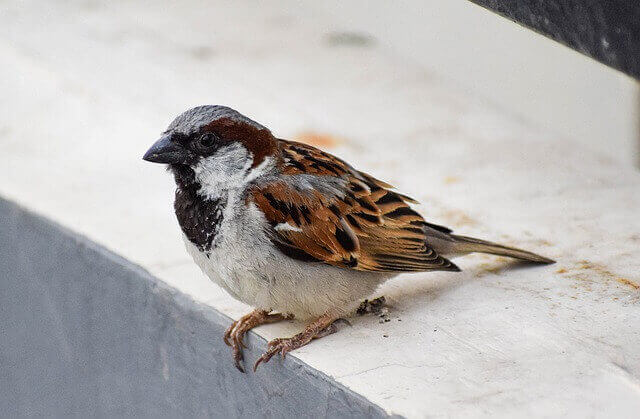
- Length: 5.9-6.7 in (15-17 cm)
- Weight: 0.9-1.1 oz (27-30 g)
- Wingspan: 7.5-9.8 in (19-25 cm)
- Scientific Name: Passer domesticus
- Frequency of Occurrence: 25.31%
- Where To Find Them: They are also common in the Boston metropolitan area, but they can be found throughout the state.
- How to Attract Them: They are attracted to a variety of seeds, but in particular they love sunflower and safflower seeds. In winter, offer them cracked corn or thistle seeds as well.
General Information: The house sparrow is a common bird in Massachusetts, but its distribution range can be quite diverse. The house sparrow is found throughout the state, but its range includes the mountains, foothills, and coastal areas. House sparrows primarily eat grains, seeds, and insects.
They are also known to feed on garbage. In winter, house sparrows are typically seen in urban areas or near open spaces with plenty of food sources. They are occasional visitors to homes during the colder months.
Handpicked Related Post: Birds That Look Like Sparrows: 16 Most Common Types!
European Starling
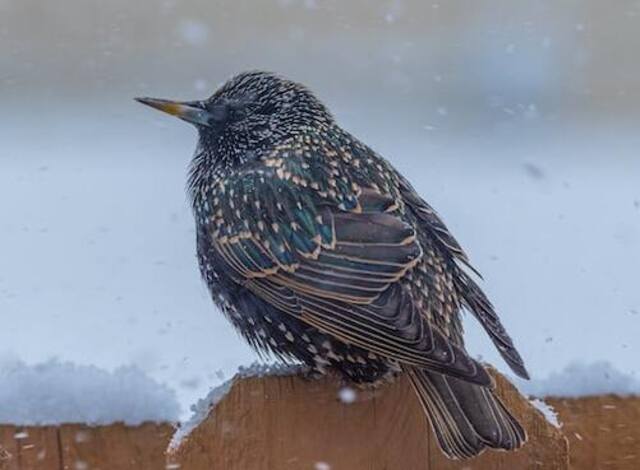
- Length: 7.9-9.1 in (20-23 cm)
- Weight: 2.1-3.4 oz (60-96 g)
- Wingspan: 12.2-15.8 in (31-40 cm)
- Scientific Name: Sturnus vulgaris
- Frequency of Occurrence: 21.04%
- Where To Find Them: European Starlings are migratory birds that can be found in a variety of locations throughout Massachusetts during the winter. These birds are usually seen in areas that have a lot of trees, such as the Boston area or the North Shore. They will also be found near bodies of water, such as the Charles River or the Merrimack River.
- How to Attract Them: If you want to attract the European Starling, you need to provide them with a food source that they are familiar with. Mealworms will be their favorite option, but you can also try feeding them white proso millet or cracked corn in winter.
General Information: European Starlings are a common bird in North America and parts of Europe, but they are not well known in the eastern United States. They can be found throughout most of Massachusetts, except for the far north and the far south.
European Starlings prefer open areas with plenty of trees and other vegetation to build their nests, such as parks, large gardens, orchards, and rural areas. They eat a variety of insects, seeds, nuts, berries, grains,, and sometimes meat. In winter, they are common visitors to many towns and cities across Massachusetts.
Handpicked Related Post: How To Attract European Starlings To Your Yard Fast?
House Finch
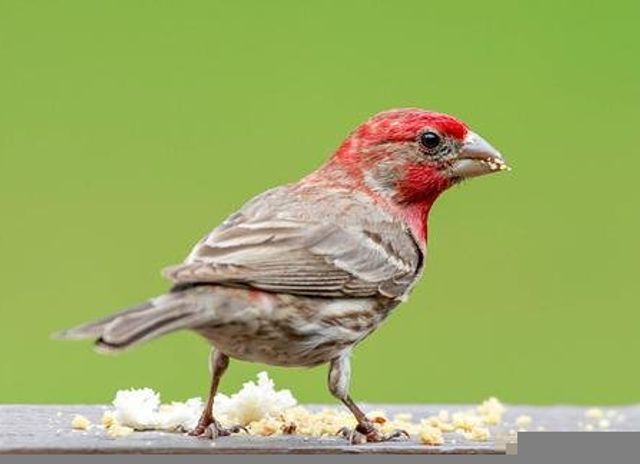
- Length: 5.1-5.5 in (13-14 cm)
- Weight: 0.6-0.9 oz (16-27 g)
- Wingspan: 7.9-9.8 in (20-25 cm)
- Scientific Name: Haemorhous mexicanus
- Frequency of Occurrence: 19.09%
- Where To Find Them: These birds can be seen in locations such as Boston, Worcester, and Lowell.
- How to Attract Them: One way to attract these birds is to offer them black-oil sunflower seed. Cracked corn is also a good food for house finches, as it’s high in energy and contains many essential nutrients.
General Information: The house Finch is a small passerine bird that ranges throughout much of North America. In Massachusetts, their distribution range includes the eastern half of the state and parts of New Hampshire and Maine. They are found in a variety of habitats, from woodland to farmland, but they prefer areas with some vegetation cover.
The house Finch feeds on plant materials, including seeds, buds, and fruit. They are primarily seed-eaters, but will also consume small animals or insects. House Finches are common winter visitors to Massachusetts; many people report seeing them around homes or in parks during this time of year.
Handpicked Related Post: How to Attract House Finch to your Yard? (Easy & Fast)
White-throated Sparrow
- Length: 6.3-7.1 in (16-18 cm)
- Weight: 0.8-1.1 oz (22-32 g)
- Wingspan: 7.9-9.1 in (20-23 cm)
- Scientific Name: Zonotrichia albicollis
- Frequency of Occurrence: 18.85%
- Where To Find Them: In Massachusetts, the White-throated Sparrow is most commonly seen in winter in the Boston area and on Cape Cod. They are also seen in some other parts of the state, but they are not as common. In winter, they often frequent open areas with plenty of trees and shrubs nearby.
- How to Attract Them: It is a winter visitor to many areas, and can be attracted to feeders with cracked corn, white proso millet, black oil sunflower seed, or in winter, yarrow or dandelion seeds.
General Information: The white-throated sparrow is a common winter visitor to Massachusetts. The distribution range of this bird includes much of the eastern half of the United States, as well as parts of Canada and Mexico. They commonly inhabit woodlands and open areas with scattered trees, but are also found in urban areas.
The diet of the white-throated sparrow consists mainly of insects, but they will also eat small amounts of fruits and seeds. In Massachusetts, this bird is most commonly seen in late winter and early spring, when they are attracted to seeds and grasses.
Red-bellied Woodpecker
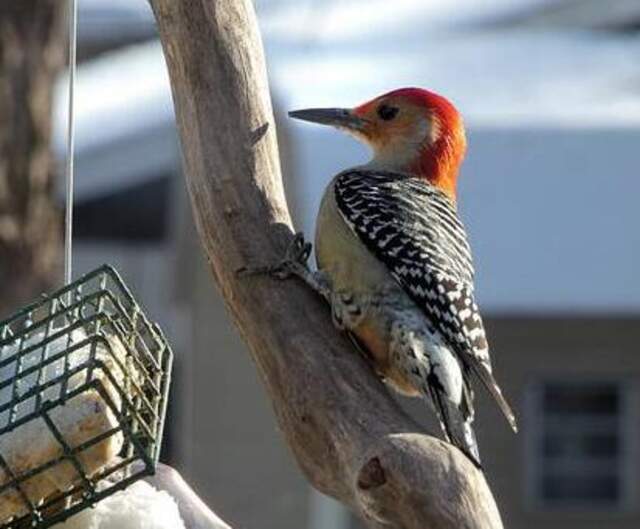
- Length: 9.4 in (24 cm)
- Weight: 2.0-3.2 oz (56-91 g)
- Wingspan: 13.0-16.5 in (33-42 cm)
- Scientific Name: Melanerpes carolinus
- Frequency of Occurrence: 18.53%
- Where To Find Them: These woodpeckers are most commonly seen in the Boston area, but they have also been spotted in the Berkshire Mountains and near Northampton.
- How to Attract Them: To attract the Red-bellied Woodpecker to your backyard, try providing them with suet and peanuts in winter. Black oil sunflower seed is also a good option – just be sure to offer plenty during the peak feeding times of early morning and late afternoon.
General Information: The red-bellied woodpecker is a common bird in Massachusetts. They are found in most of the state, with the exception of Cape Cod and the Islands. Their distribution range includes most of New England, from Canada to Florida. The woodpeckers prefer deciduous and mixed forests, but they will also inhabit pine plantations and towns.
The red-bellied woodpecker eats insects, fruits, nuts, and seeds. They are especially fond of berries, especially blueberries. In winter, they are often seen visiting agricultural areas for food.
Handpicked Related Post: How to Attract Red-bellied Woodpeckers to your Yard?
Carolina Wren
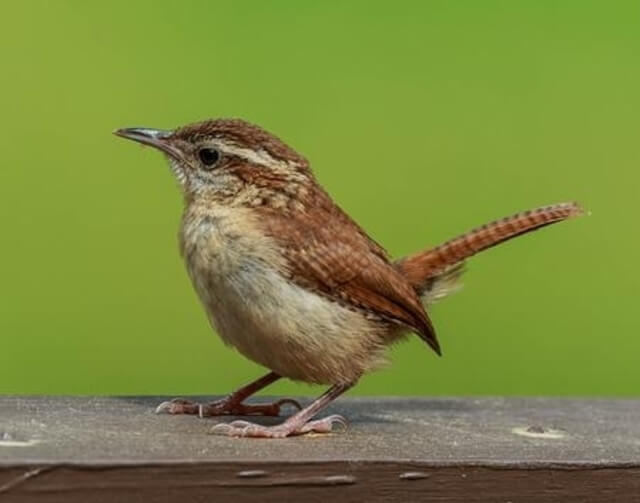
- Length: 4.7-5.5 in (12-14 cm)
- Weight: 0.6-0.8 oz (18-22 g)
- Wingspan: 11.4 in (29 cm)
- Scientific Name: Thryothorus ludovicianus
- Frequency of Occurrence: 16.84%
- Where To Find Them: In Massachusetts, this bird can be seen during winter in locations such as the Berkshires and the Pioneer Valley. This bird is a passerine and tends to forage for food on the ground.
- How to Attract Them: There are many ways to attract Carolina Wrens to your backyard. One way is to provide them with a suet feeder filled with peanuts or black oil sunflower seeds.
General Information: The Carolina wren is a small bird that can be found in the eastern and central United States. This bird is a common winter visitor to Massachusetts. The Carolina wren’s distribution range includes the eastern seaboard from North Carolina to Florida, as well as the Midwest and parts of the West.
The habitat of this bird includes woodlands, shrubs, and trees. The diet of the Carolina wren includes insects, worms, and other small creatures.
Handpicked Related Post: How to Attract Wrens to your Backyard? (Expert’s Guide)
Hairy Woodpecker
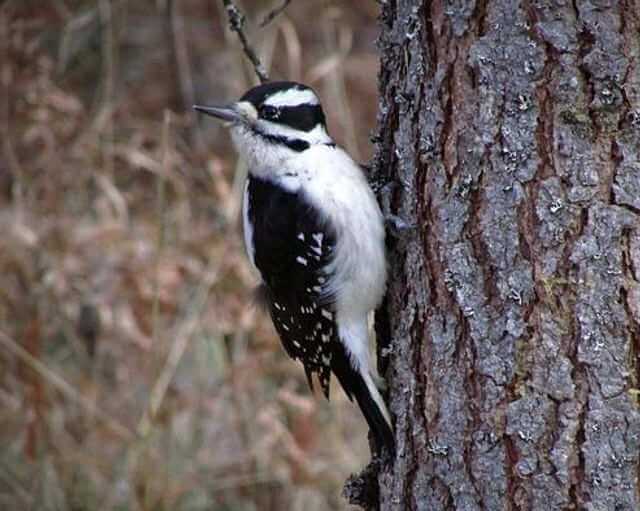
- Length: 7.1-10.2 in (18-26 cm)
- Weight: 1.4-3.4 oz (40-95 g)
- Wingspan: 13.0-16.1 in (33-41 cm)
- Scientific Name: Leuconotopicus villosus
- Frequency of Occurrence: 11.06%
- Where To Find Them: In Massachusetts, it is most common in the North Shore and Cape Cod areas. This woodpecker is usually seen in open woods during winter, but can also be found near human habitation.
- How to Attract Them: To attract this bird to your property, you will need to provide it with food sources that it prefers. One of the best ways to do this is by feeding it suet or peanuts, and you can also offer black oil sunflower seeds as a food source.
General Information: The hairy woodpecker is a widespread bird throughout the eastern and central United States. It also inhabits much of Canada and parts of Mexico. The distribution range of the hairy woodpecker includes both prairies and deciduous forests, as well as urban areas.
The wood-boring insects that the hairy woodpecker eats are most commonly found in oak and maple trees, but it will also consume other types of insects. In winter, the hairy woodpecker may visit various kinds of berry-producing trees in Massachusetts.
American Tree Sparrow
- Length: 5.5 in (14 cm)
- Weight: 0.5-1.0 oz (13-28 g)
- Wingspan: 9.4 in (24 cm)
- Scientific Name: Spizelloides arborea
- Frequency of Occurrence: 10.64%
- Where To Find Them: They are most commonly seen in winter, when they are located in areas such as the suburbs of Boston, the Merrimack Valley, and Cape Cod.
- How to Attract Them: In winter, these birds prefer feeders filled with Millet and sunflower seed. Cracked corn is also a big hit, as are bird feeders that feature these types of food. All of these items can be found at most stores during the winter.
General Information: The American Tree Sparrow is found throughout much of North America. The distribution range includes most of Canada, the northern United States, and much of Mexico. In Massachusetts, the American Tree Sparrow can be found in all but the farthest reaches of Cape Cod.
The American Tree Sparrow prefers woodlands with lots of trees and shrubs for nesting and foraging. They eat seeds, berries, insects, and other small creatures. During winter, when food is scarce, they will visit gardens to find seeds or berries on trees.
Handpicked Related Post: 10 Fascinating American Tree Sparrow Facts
Rock Pigeon
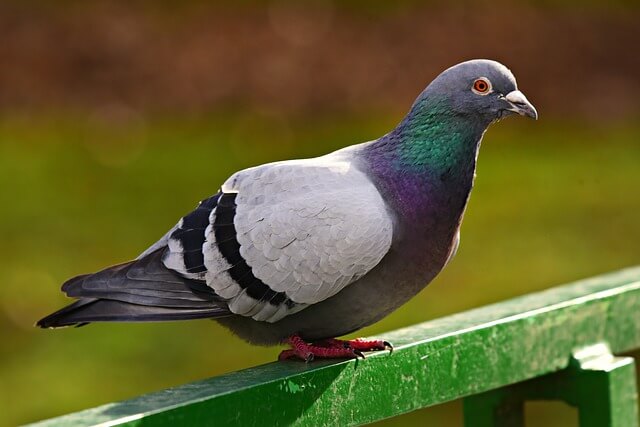
- Length:11.8-14.3 in(30-36 cm)
- Weight: 9.3-13.4 oz (265-380 g)
- Wingspan: 19.7-26.5 in (50-67 cm)
- Scientific Name: Columba livia
- Frequency of Occurrence: 10.20%
- Where To Find Them: The rock pigeon is a common sight in many parts of the state, including the Berkshires, Cape Cod, and the Pioneer Valley.
- How to Attract Them: If you are looking to attract the Rock Pigeon in winter, you should try feeding them millet, sunflower seeds and corn. Sorghum can also be a good option for these birds.
General Information: The rock pigeon, Columba livia, is a common bird in Massachusetts. The distribution range of this bird extends from Nova Scotia to Florida and west to Texas. Habitat consists of open areas with scattered trees and rocks, such as urban areas, fields, and woodlands.
The diet includes seeds, insects, and other small prey. Rock pigeons are one of the few birds that feed primarily on seeds in the winter. These birds are common winter visitors to Massachusetts and can be found in most parts of the state.
Handpicked Related Post: Birds that look like Pigeons (Photos, ID & Stats)
Northern Mockingbird
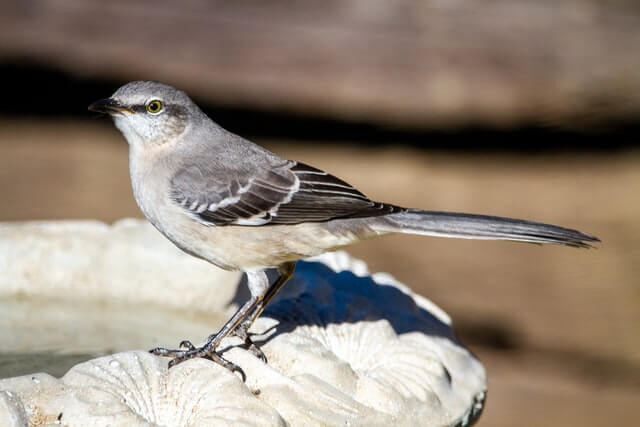
- Length:8.3-10.2 in (21-26 cm)
- Weight: 1.6-2.0 oz (45-58 g)
- Wingspan: 12.2-13.8 in (31-35 cm)
- Scientific Name: Mimus polyglottos
- Where To Find Them: In Massachusetts, these birds can be found in most parts of the state, but they are most commonly seen in Essex County, Franklin County, Hampden County and Middlesex County.
- How to Attract Them: In order to attract this popular bird to your yard, you can feed it winter mealworms on a platform feeder, or a suet feeder with insect or berry suet.
- Frequency of Occurrence: 9.75%
General Information: The Northern Mockingbird is a common resident and migrant in the eastern United States. It ranges in distribution from southern Canada south to the Gulf of Mexico and west to the Rocky Mountains. In Massachusetts, it is most commonly found in the Berkshires and north-central New Hampshire.
The Northern Mockingbird primarily eats insects, but also consumes small amounts of seeds, berries, fruits, and worms. During winter, it favors areas with abundant berries and trees with wild fruit.
Handpicked Related Post: How to Attract Mockingbirds to your Yard? (Expert Tips)
Northern Flicker
- Length: 11.0-12.0 in (28-31 cm)
- Weight: 3.9-5.6 oz. (110-160 g)
- Wingspan: 16.5-20.0 in (42-51 cm)
- Scientific Name: Colaptes auratus
- Frequency of Occurrence: 8.16%
- Where To Find Them: The Northern Flicker can be seen in a number of locations in Massachusetts during the winter months, including the eastern shore of Cape Cod and the Berkshire Hills region of western Massachusetts.
- How To Attract: If you’re looking to attract the Northern Flicker to your backyard in winter, providing a feeder of shelled peanuts and hulled sunflower seeds is a great way to do it. These small feeders will keep the birds happy all winter long, and they’ll appreciate the extra protein your yard provides.
Description: Northern flickers are a common winter backyard birds in Massachusetts. They live in the northern United States and Canada, and their distribution range includes most of New England. Northern flickers eat insects, seeds, nuts, and fruit. Some of their favorite foods include tree nuts and seeds, especially those from willow trees.
They usually feed in the early morning or late evening. Northern flickers migrate to warmer areas during the winter. Many stay in Massachusetts, but some migrate as far south as Florida. During winter, they often visit feeders.
Handpicked Related Post: How to Attract Northern Flickers to your Backyard (Easy)
Red-breasted Nuthatch
- Length: 4.3 in (11 cm)
- Weight: 0.3-0.5 oz (8-13 g)
- Wingspan: 7.1-7.9 in (18-20 cm)
- Scientific Name: Sitta canadensis
- Frequency of Occurrence: 7.33%
- Where To Find Them: Red-breasted Nuthatches are common winter backyard birds in Massachusetts. These birds are typically seen in areas with dense trees and shrubs, such as the Boston metropolitan area, southeastern New Hampshire, and parts of Rhode Island.
- How to Attract Them: To attract this bird to your garden in the winter, try providing her with shelled peanut pieces, black oil sunflower seeds, peanut butter, and suet.
General Information: The red-breasted nuthatch (Sitta canadensis) is a common bird in Massachusetts. The distribution range for this species stretches from the Carolinas and Georgia to New England, including Massachusetts. This nuthatch typically inhabits coniferous forests, although it will also occupy deciduous woodlands.
This bird feeds on insects, fruits, and seeds. In Massachusetts, the red-breasted nuthatch is most commonly seen in early winter, when it visits tree nuts and seeds available on the trees.
Handpicked Related Post: How to Attract Nuthatches to your Backyard? Expert Tips!
Related Post: 34 Most Common Backyard Birds in Massachusetts (2022)

